Bengal Slow Loris is a small, nocturnal primate found in the forests of north-eastern India and Nepal. These animals are threatened by habitat destruction and hunting, and their population is estimated to be as low as 2,500-10,000 individuals.
- Status: Vulnerable
- Known as: Bengal Slow Loris, Bengal loris, northern slow loris
- Estimated numbers left in the wild: Perhaps 2,000 to 16,000 – exact numbers are unknown.
The biology of the Bengal Loris is fascinating. They are the only venomous primate in the world, and they use their venom to stun prey. They also have a very low metabolic rate, which allows them to go for long periods without food or water.
These fascinating nocturnal species are considered vulnerable by the IUCN, and many efforts are underway to conserve this species.
One such effort is the “Bengal Slow Loris Conservation Project” in India, which is working to protect the lorises’ habitat and raise awareness about this animal’s plight.
Description
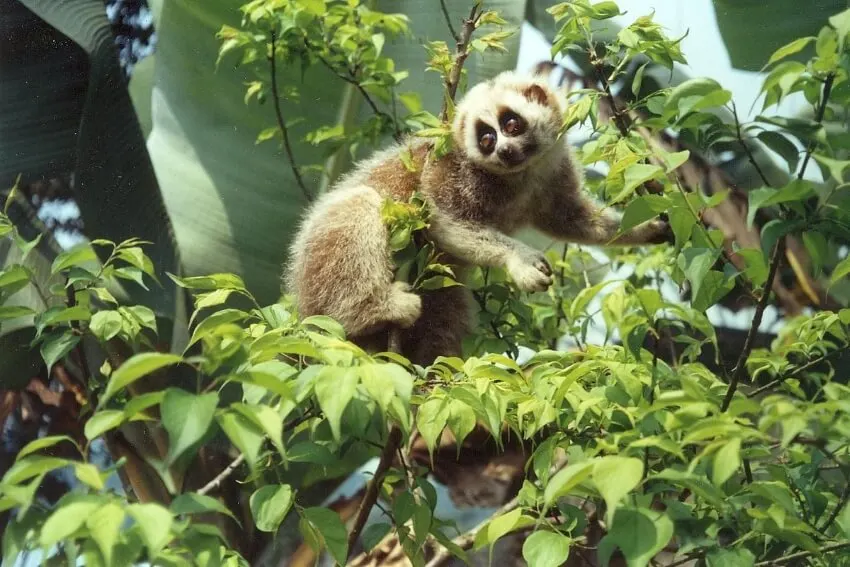
Like all loris species, the Bengal loris shows that nature sometimes has a sense of humor. The name loris originates in the Dutch word for a clown. Possessing around, slightly startled looking, flat face, narrow tongues, and wet nose, the Bengal loris is between 27 and 36 centimeters long and weighs 1 to 2 kilograms.
The fur of the slow loris is thick and woolly, with lighter coloration on the face, front limbs, and underside and dull, medium-brown fur elsewhere. The hands and feet of the slow loris are well suited to its arboreal lifestyle, permitting the animal to grasp vines and branches securely.
The Bengal loris does, indeed, move very slowly. It is also very cautious as it goes through the trees in search of food, always keeping three of its ‘hands’ in contact with the substrate at all times.
The Bengal loris eats nectar, bird’s eggs, fruit, and insects but is especially fond of the sap and gum that oozes from trees, often due to the loris biting through the bark to stimulate sap flow.
The tooth-comb in the lower jaw is used for grooming and scraping gum off trees. The Bengal slow loris is an important pollinator in its rainforest home.
Few mammals produce toxins (the short-tailed shrew is one), but the Bengal slow loris, like other slow lorises, has a gland on the inside of its arm that does produce a toxin that it rubs on its face, neck and tooth-comb.
The substance provides information about the animal to other of its species and also can produce painful wounds in those the loris bites. The poison is also used to delineate home territories. During the day, the Bengal slow loris curls up into a ball and sleeps in the trees, usually in cavities in trees or dense cover.
Anatomy and Appearance
The Bengal Slow Loris is a small, reddish-brown primate found in India and Nepal’s forests. These animals have a round head, large eyes, and a pointed snout. They weigh between 200 and 400 grams and measure between 20 and 26 cm in length.
They are threatened by habitat destruction, loss, and hunting, and their population is estimated to be as low as 2,500-10,000 individuals.
The biology of the Bengal Loris is still relatively unknown. However, it is known that they are very sensitive to environmental changes and that they can live for up to 20 years in the wild. The Bengal loris is a sexually dimorphic species, meaning that the males and females look different.
Adult males have a black face and body, while females are lighter in color. Additionally, the males have a characteristic black mustache-like stripe on their upper lips.
Location & Habitat
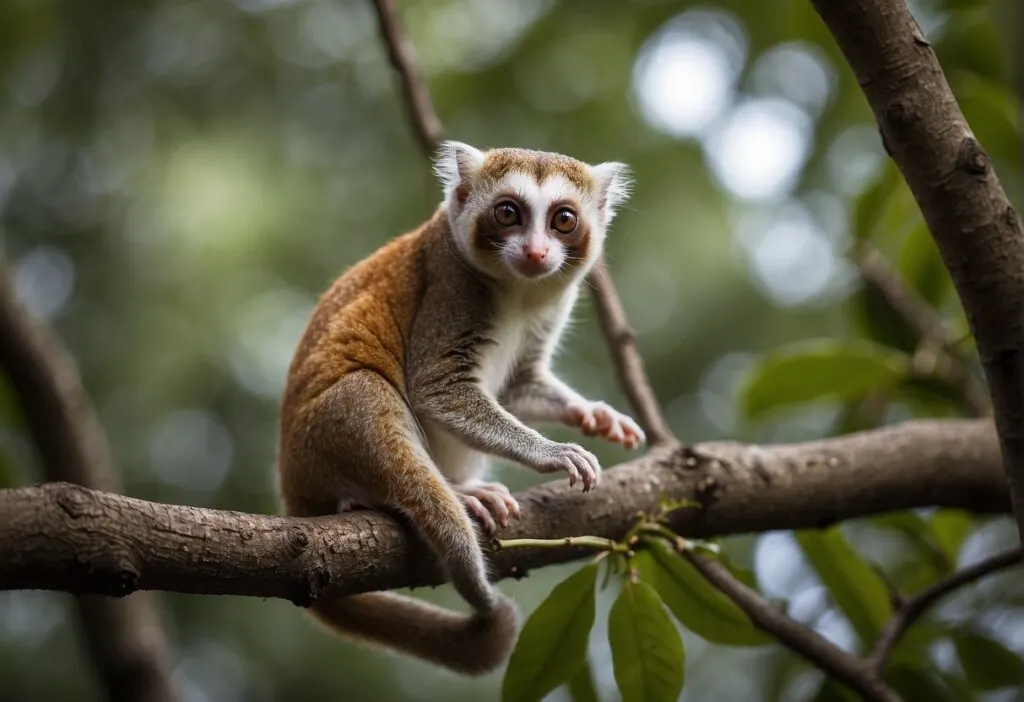
The Bengal slow loris is found in northeast India, Bangladesh, Myanmar, Thailand, China, Vietnam, and Cambodia’s primary forest. The Bengal Slow Loris is found in India and Nepal’s tropical, moist deciduous forests, with forest edges and dense vegetation.
These forests are characterized by their high levels of biodiversity and are home to various threatened species, including the Bengal species.
Species of arboreal and nocturnal living in evergreen and semi-evergreen forests prefer areas where thick canopy cover has appeared, and insects have appeared more abundant in the forests around it. It is primarily frugivorous (fruit eats), but eats insects, gums, and small reptiles. They also group in small families.
See Related: Different Types of Terrain Around the World
Diet and Nutrition
The Loris nocturnal species is a carnivore whose diet consists of insects, spiders, and small vertebrates. They also feed on fruits and leaves. They are the only loris species that can swim and often cross rivers to reach new feeding areas.
Bengal Slow Loris Mating Habits
The mating habits of the Bengal loris have not been well studied, but it is thought that they are monogamous. Little is known about their reproductive behavior, but they are assumed to have a single offspring every year.
What is known, though, is that the male is attracted to the female by her fragrance. He will follow her and keep her in view until she is ready to breed. Males typically respond by smelling the urine markings and whistling towards the female, thus encouraging her to urinate again.
Mating occurs in late winter or early spring, and gestation lasts around six months. Gestation lasts for around six months, and the young are weaned at around six months old. Newborn slow lorises are very small and weigh only around 60 grams.
See Related: List of Animals That Mate for Life
Behavior and Family Structure
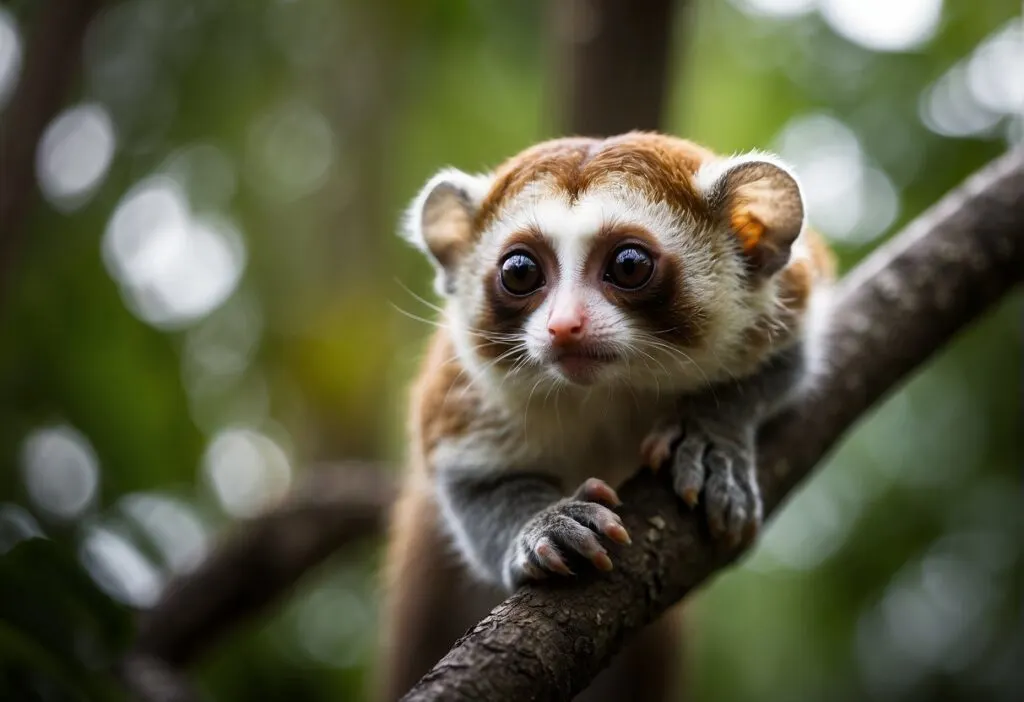
The Bengal Loris are altricial, meaning they are born completely dependent on their parents for care and feeding. Young, slow lorises stay with their parents for around two years, so they learn how to find food and protect themselves from predators.
This slow loris species is a relatively solitary animal. They have been observed to live in groups of two to four individuals, but it is more common for them to be lone animals. They are not territorial and do not defend their home range.
A single young (twins are very rare) is produced every year or year and a half, with the baby riding on its mother’s back. While little is known about the habits of the slow loris, it seems likely that small family groups, consisting of the mother and several offspring, form the basis of their social life.
Lorises will sometimes sleep in small adult groups as well. The Bengal loris often establishes dozens of sleeping sites in its territory. Cryptic coloration, sleeping during the day, and slow movement help the Bengal loris avoid predators.
Life Cycle
The gestation period for a Bengal Slow Loris is about six months. Infants are born relatively small, weighing around 100 grams, and are weaned at around four months old.
Young lorises stay with their mothers until they are around one year old, and then they disperse to find their territory. The adult’s slow loris also have a home range of around 0.5-2 hectares.
Role in the Ecosystems
The Bengal Loris is an important part of the ecosystems in which it lives. It is a slow, timid creature that feeds mostly on insects but also helps pollinate trees and plants.
Its presence is necessary for maintaining the balance of the environment. Additionally, the loris is an important part of the local people’s cultural heritage.
Unfortunately, the Bengal Loris is threatened by habitat loss and hunting. Their population is estimated to be as low as 2,500-10,000 individuals. This means that they are in danger of becoming extinct if we do not take steps to protect them. These tiny animals are beautiful creatures, and it is important to save them.
Predators
The Bengal Slow Loris is threatened by a number of predators, including leopards, pythons, and owls. These animals are preyed upon due to their habit of living on the ground and their vulnerability while feeding. Losing trees in their habitat has also made them more susceptible to predation.
Bengal Slow Loris vs Other Slow Loris
The Bengal Slow Loris (Nycticebus bengalensis) is a little-known and highly endangered primate found in the forests of India and Nepal. The other slow loris species include the Sunda Slow Loris (Nycticebus coucang) in Southeast Asia and the Philippine Slow Loris (Nycticebus pygmaeus) in the Philippines.
All slow loris species are threatened by habitat loss and hunting, and their populations are estimated to decline. It is a unique species of primate that is highly endangered. It is closely related to the other loris species, like pygmy slow loris, but several key differences make it unique.
For example, the Bengal loris has reddish-brown fur, while other loris species have more gray fur. They also have a pronounced, round nose and smaller eyes than other loris species.
Bengal Slow Loris Facts
The Bengal Slow Loris is a fascinating creature! Here are some fun facts about them:
- They are the only primates in the world that can turn their heads 180 degrees!
- They have a very long lifespan, living up to 20 years in the wild.
- They are solitary animals, except for mothers and their young.
- These small nocturnal species are also unique biologically. Here are some of the things that make them special:
- They are the only primates that can produce cyanide!
- They have a very low body temperature, which allows them to move more easily at night.
- They are the smallest loris species, weighing just over 1 pound.
Conservation Status
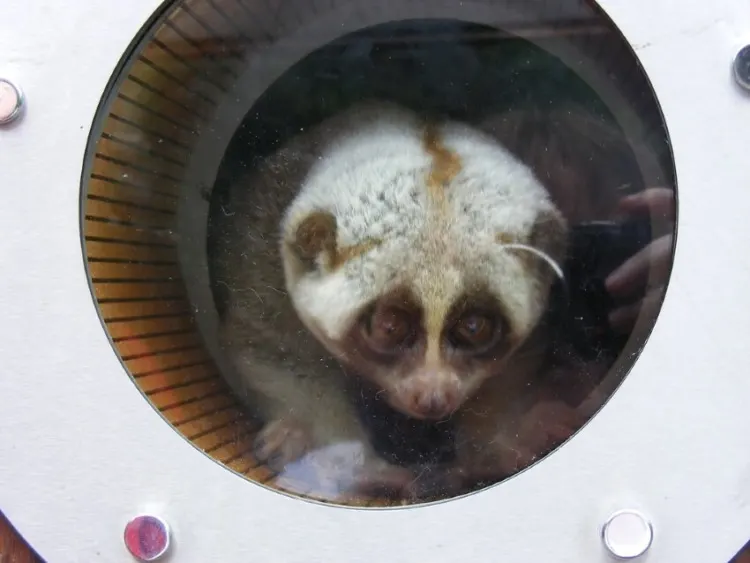
The Bengal Slow Loris is a vulnerable species of primate found in the forests of India and Nepal. These animals are threatened by habitat destruction, predation, disease, and hunting.
Threats
The main reason for the decline in the population of the Bengal loris is habitat loss. The forests where these animals live are being destroyed for farmland and development.
Habitat destruction due to farming, logging, and mining are the greatest threats to the Bengal loris, although the animal is still hunted for food by local populations.
Superstition decrees that certain parts of the loris are valuable as medicine, so they are still shot for body parts for traditional formulations. The species are also captured live for the pet trade. Their most serious natural predators are raptors and pythons.
Conservation efforts
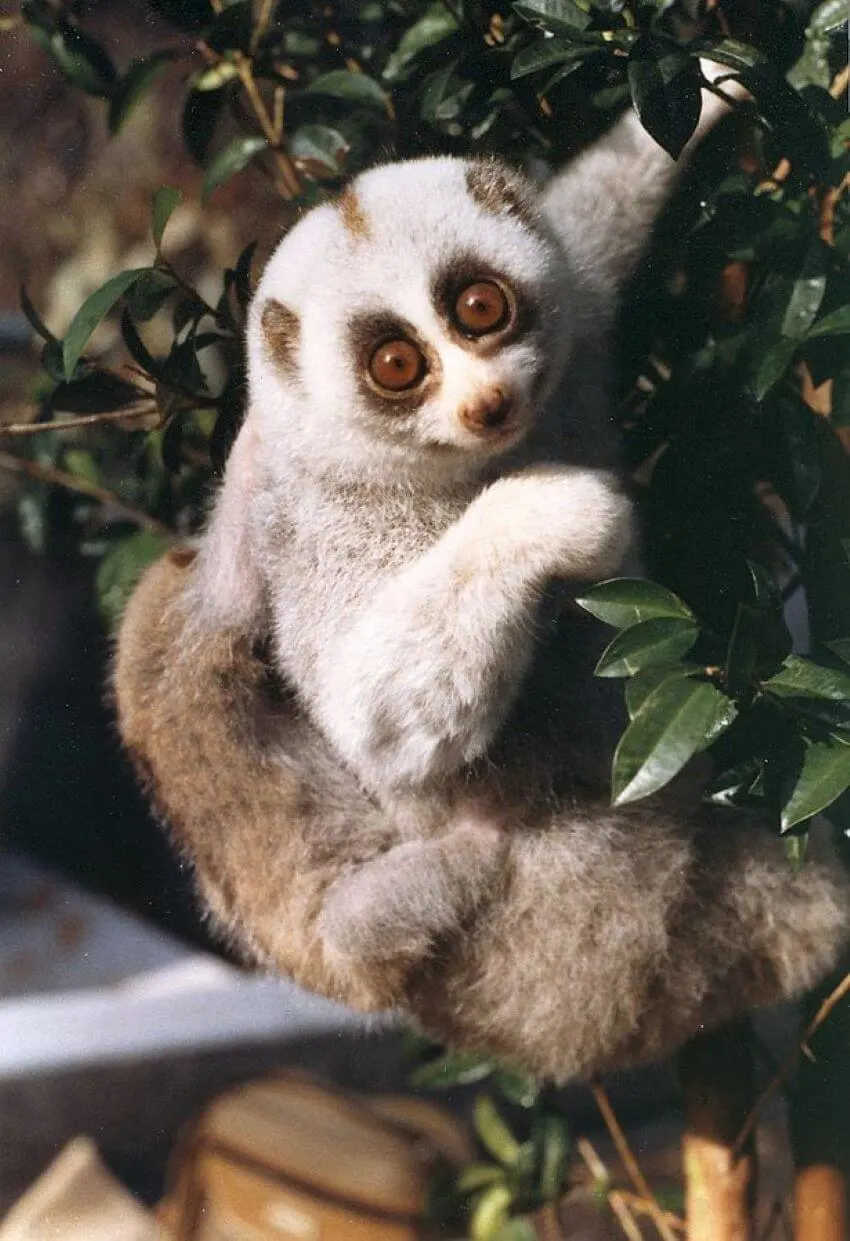
The Bengal loris has been placed in the highest protective category in CITES, whereby all animal trade is forbidden.
Protection has been given in most countries where the loris is found, and establishing national parks has helped preserve the animals and the environment they require.
Here’s a list of the conservation efforts
- The first conservation effort to save the slow lorises is to increase public awareness of the animal and its plight. Many people are unaware that the Bengal loris even exists, and more education about the species will help to create support for its conservation.
- The second conservation effort is to protect the Slow loris’ habitat. The forests where these animals live are being destroyed at an alarming rate, and if this continues, the Bengal loris will soon be extinct.
- The third conservation effort is to stop the hunting of Bengal lorises. They are killed for their meat and fur, and this is another major threat to their survival.
Organizations
World Wildlife Fund
The Word Wild Fund (WWF) is an international non-governmental organization that engages in worldwide conservation, research, and education programs. The WWF was founded in 1961 and works in more than 100 countries to promote sustainable use of natural resources, protect endangered species, and reduce human environmental impact.
One of the WWF’s main focuses is on the conservation of primates, including the Bengal Slow Loris. The Bengal Slow Loris is a fascinating creature that is in danger of becoming extinct. Habitat loss, hunting, and predation are the main threats to their survival. Efforts are being made to protect them, but more needs to be done if this little-known primate is saved.
FAQ
What is the Bengal slow loris?
The Bengal loris is a primate that lives in India and Nepal’s jungles. These animals are imperiled by habitat loss and hunting, with estimates suggesting their number may be as low as 2,500 to 10,000 individuals.
What are the threats to the Bengal slow loris?
The Bengal slow loris is threatened by habitat loss and hunting. Habitat loss occurs when forests are cleared for development or agriculture, which reduces the available habitat for these animals.
Hunting is also a major threat, as Bengal loris are killed for their fur or to be sold as pets. These animals are very slow and defenseless, making them an easy target for hunters.
Why are Bengal loris are they endangered?
Due to habitat loss and hunting, bengal slow loris populations are estimated to be as low as 2,500-10,000 individuals. They are threatened by the destruction of their forest habitat and are hunted for the illegal pet trade.
What is being done to save Bengal loris?
Although the Bengal slow loris is currently listed by IUCN as vulnerable and protected by Indian law, it has not been studied much.
The Bengal loris is widespread in habitat types, from moist evergreen forests to dry deciduous forests, grasslands, scrublands, and thorn forests. However, Bengal lorises are threatened by habitat destruction, loss, and hunting.
How to help Bengal Slow Loris?
People can help Bengal slow loris in a few ways. First, Bengal loris lives in Asia so the most important thing people might want to do is protect Bengal lorises habitat.
It’s also important to encourage governments in Bengal slow loris’s home range to enforce conservation measures like anti-trafficking laws and to make it illegal to own Bengal lorises as pets.
Finally, people can spread the word about Bengal’s slow loris conservation to friends and family.
Other Species Profiles
See Related
